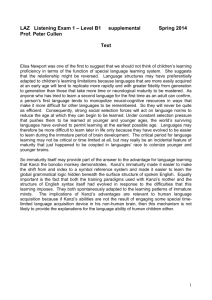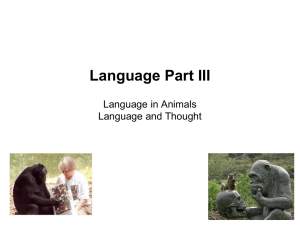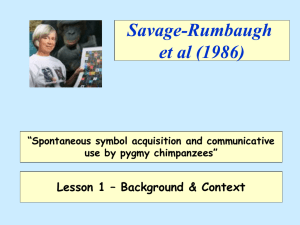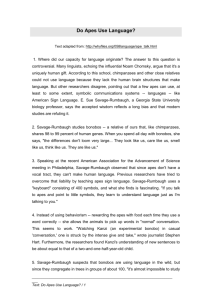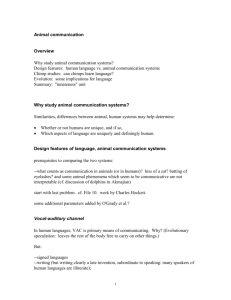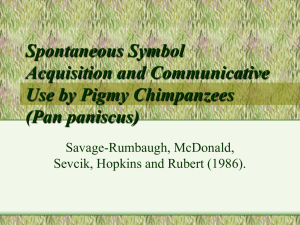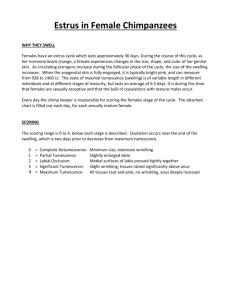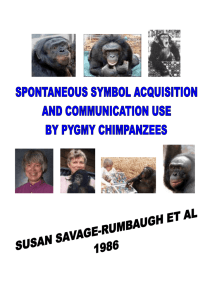Kanzi
advertisement
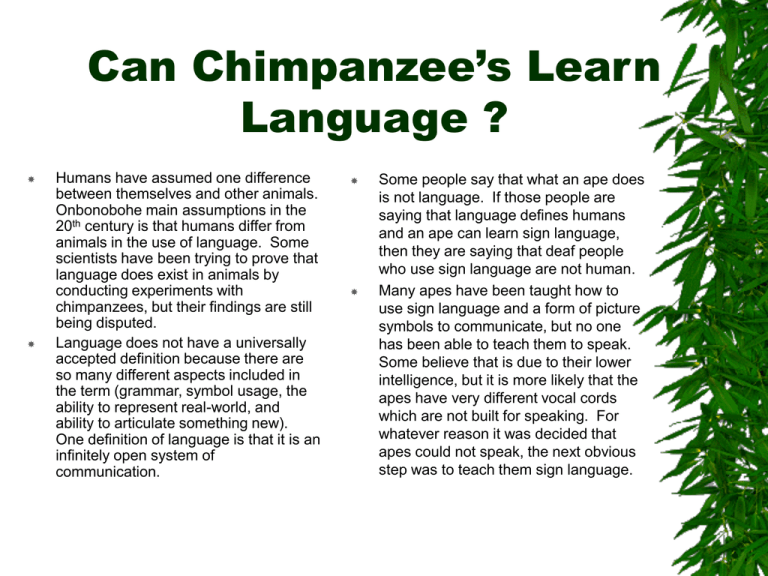
Can Chimpanzee’s Learn Language ? Humans have assumed one difference between themselves and other animals. Onbonobohe main assumptions in the 20th century is that humans differ from animals in the use of language. Some scientists have been trying to prove that language does exist in animals by conducting experiments with chimpanzees, but their findings are still being disputed. Language does not have a universally accepted definition because there are so many different aspects included in the term (grammar, symbol usage, the ability to represent real-world, and ability to articulate something new). One definition of language is that it is an infinitely open system of communication. Some people say that what an ape does is not language. If those people are saying that language defines humans and an ape can learn sign language, then they are saying that deaf people who use sign language are not human. Many apes have been taught how to use sign language and a form of picture symbols to communicate, but no one has been able to teach them to speak. Some believe that is due to their lower intelligence, but it is more likely that the apes have very different vocal cords which are not built for speaking. For whatever reason it was decided that apes could not speak, the next obvious step was to teach them sign language. Why Teach Language To Apes? Since the theory of evolution became known and accepted by many individuals, some scientists sought to find new ways to separate humans from animals. Humans are generally thought to be the only animals that use complex language. By studying if apes can learn language, scientists were hoping to shed some light on the nature of language, cognitive, and intellectual capacities. They were also hoping to explain issues on the uniqueness of language and thought used by humans. Other scientist were interested in training apes to develop teaching techniques to use with mentally retarded children. Past Experiments Of Teaching Chimpanzees Language! Allen and Beatrice Gardner began teaching sign language to an infant chimpanzee named Washoe in 1966. Other apes were eventually taught sign language and they used it to communicated to friends, strangers, each other, themselves, dogs, cats, and even trees. A chimp named Loulis even learned sign language indirectly. David Premack used plastic tokens to train a chimp named Sarah. The tokens represented words, and varied in shape, size, texture, and color. He used a stranger, new trainer, to test whether she truly understood language and they found she could still give the correct answer to questions asked. Duane Rumbaugh used another language system, an electronic keyboard, with a chimp named Lana. By learning symbols for specific words, Lana learned to communicated. She began initiating using the PERIOD key as a marker to begin a new sentence. She also began using NO as a protest when someone else received something she wanted (Coke). Herbert S. Terrance was skeptical of the success of the chimps listed above, so he started and experiment with a chimp named Nim. He was raised like a human child and only received approval as a reward for signing. Although Nim learned many words, Terrace concluded that Nim could not combine words to create new meaning on his own. What Is Special About Kanzi? Kanzi is Bonobo, also called the pygmy chimpanzee. Bonobos have a number of other traits which suggest it is a close cousin of ours genetically. They are more humanlike than common chimps in many ways, including being more vocal, communicative, having humanlike expressions on their faces, and they are less aggressive and friendly towards humans. Their bodies are slightly smaller, more graceful in build, have longer legs, and have a smaller skull than normal chimps. Kanzi, an unusually intelligent Bonobo chimp recently trained at Georgia State University, is remarkable in that he learned to use around 200 symbols on a portable electronic symbol board, a computer with buttons in the shape of absolute arbitrary symbols, rather than manual signs. More interestingly, Kanzi learned how to use this board while watching his foster mother, Matata, being taught by traditional reinforcement methods. So Kanzi did learn how to use arbitrary symbols without being taught, although he did observe direct reinforcement of each symbol during the process and the symbols were taught one at the time. No ape had ever been able to determine that a specific spoken word corresponded to a picture or printed symbol without being directly taught. Kanzi’s achievements are not limited to language, but included tool use and tool manufacturing as well. Sue Savage – Kanzi’s Trainer Sue Savage was encouraged to conduct experiments by the strong claims that chimps have language competency (Washoe and Lana). She began an investigation with Sherman and Austin in a different directions than most scientists (whether or not they have language). She planned to focus on words, not sentences with pictures. By the time Herbert Terrance published his paper, Sherman and Austin had achieved a level of language competence above any other chimp before. In 1975, she began her work in Georgia with 5 bonobo chimps. She had to first gain their trust and began by showing interest in their behaviors. Sue began working with Matata using a lexigram board, which was not that successful, but her baby Kanzi learned quickly and indirectly the 10 symbols. The Implications of Teaching Chimpanzee’s Language One problem is that we have no way of communicating with apes unless we teach them some language that humans know, we will may never know their true intelligence unless we doe more studies in the wild. Another problem is what will be done with the chimps that were taught to use language. Is it cruel to remove or stop using it? What happens if they start demanding more rights, like being able to go out in public? The more that we learn about apes through these studies, the more we should be thinking about the rights and freedoms of beings. Should they have the option to be used in experiments? Is it in their best interest to learn language? Websites About Kanzi http://members.ozemail.com.au/~ilanit/koko.htm http://www.gsu.edu/~wwwlrc/biographies/kanzi.html http://pubpages.unh.edu/~jel/512/chimps/SSR.html http://ling.uta.edu/2301/notes/08.htm http://www.villagevoice.com/vls/173/dery.shtml http://www.yourdictionary.com/library/ling002.html http://www.facstaff.bucknell.edu/rbeard/chimps.html References Savage-Rumbaugh, S. & Lewin, R. (1994). Kanzi: The ape at the brink of the human mind. New York: John Wiley & Sons, Inc. NewsHour Online. (1996). Could Bonzo Go To College. http://www.pbs.org/newshour/bb/science/chimp_5-6.html Kanzi. http//www.gsu.edu/~wwwlrc/biographies/kanzi.html Language in Apes: How much do they know and how much should we teach them. http://www.math.uwaterloo.ca/~dmswitze/apelang.html
